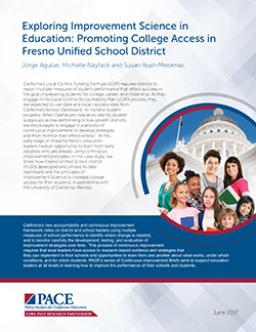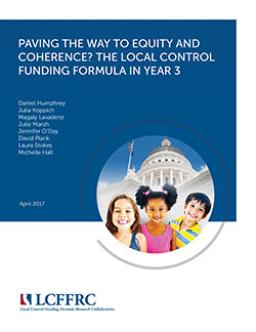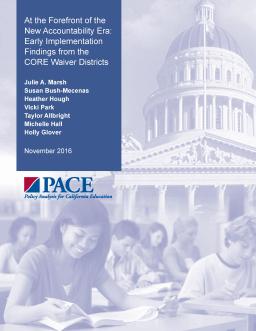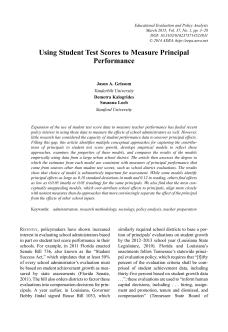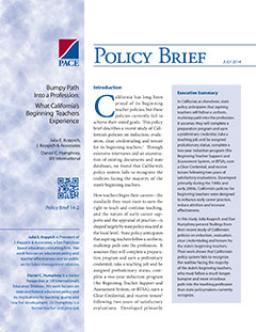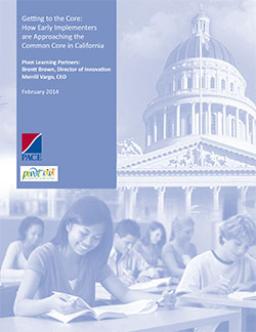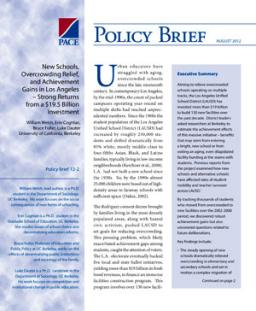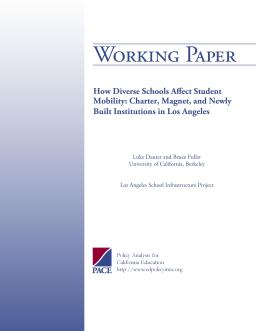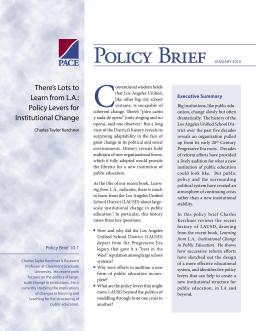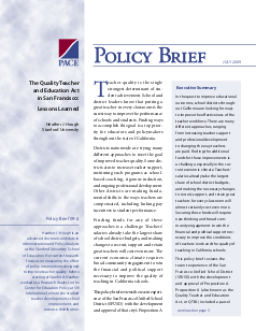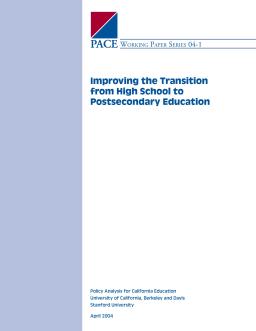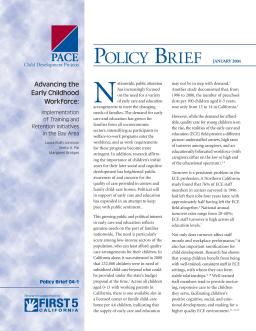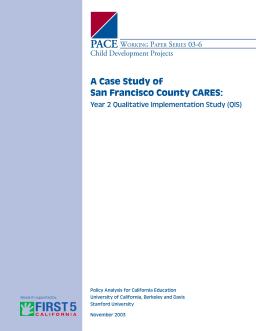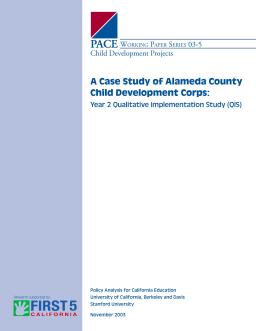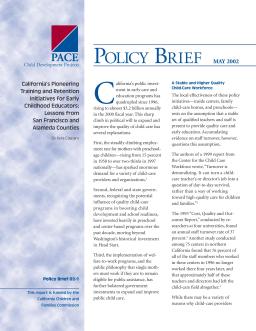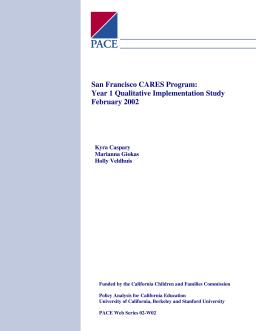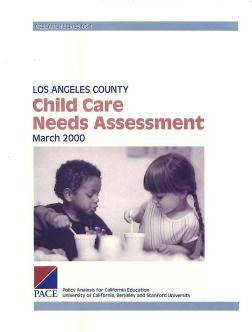Promoting College Access in Fresno Unified School District
Published
Summary
California's Local Control Funding Formula (LCFF) requires districts to report student performance measures and use state and local data to monitor progress towards preparing students for college, career, and citizenship. Fresno Unified School District (FUSD) utilized principles of Improvement Science and a data dashboard to increase college access for students, in partnership with the University of California, Merced.
The Local Control Funding Formula in Year 3
Published
Summary
The Local Control Funding Formula (LCFF) gives districts funding authority and requires input from stakeholders to create Local Control Accountability Plans (LCAPs) for equitable resource allocation and improved student outcomes. This report explores stakeholder engagement, implementation challenges, resource allocation, and equity using eight case studies. Despite limitations, this study offers valuable insights into California's K-12 education system's finance and governance.
Early Implementation Findings from the CORE Waiver Districts
Published
Summary
The Local Control and Accountability Plan (LCAP) in California and the federal Every Student Succeeds Act (ESSA) encourage local control in school accountability. The CORE waiver districts have implemented an innovative measurement system and supports for school and district improvement, providing an opportunity to learn from the enactment of a system supported by accountability policy in this new era. This report examines the early implementation and effects of the CORE reform and seeks to inform the ongoing efforts within CORE and future accountability policy in other states and districts.
Learning from the CORE Districts' Focus on Measurement, Capacity Building, and Shared Accountability
Published
Summary
California and the US are undergoing a cultural shift in school accountability policies towards locally-determined measures of school performance. Lessons can be learned from the CORE districts, which developed an innovative accountability system, emphasizing support over sanctions, and utilizing multiple measures of school quality. The CORE districts' measurement system and collaboration hold promise for improving local systems, but efforts to build capacity remain a work in progress.
Published
Summary
This article examines the use of student test score data to measure the effects of school principals on student achievement. Multiple models are developed and compared using data from a large urban school district, with results showing the importance of model choice for accurately assessing principal effects. The most conceptually unappealing models that over-attribute school effects to principals align more closely with nontest measures than do approaches that more convincingly separate the effect of the principal from the effects of other school inputs.
What California's Beginning Teachers Experience
Published
Summary
California's policies for beginning teachers assume a uniform path of completing a preparation program, BTSA, earning a Clear Credential and tenure. However, a recent study shows that the policies fail to recognize the reality of a longer, bumpier and more circuitous path faced by the majority of beginning teachers.
How Early Implementers are Approaching the Common Core in California
Published
Summary
California has adopted new Common Core State Standards (CCSS), English Language Development (ELD) standards, and Next Generation Science Standards (NGSS). The state has provided funding to support CCSS implementation, and new curriculum frameworks are nearing completion. The report focuses on early implementers of CCSS to identify lessons learned and potential pitfalls, aiming to inform practitioners and policymakers about the variety of CCSS implementation strategies California school districts are choosing.
Strong Returns from a $19.5 Billion Investment
Published
Summary
The LAUSD invested over $19B to build 130 new facilities to relieve overcrowded schools. A PACE policy brief analyzed its effects on student achievement and found robust gains for many elementary-school pupils who switched from old to new facilities. However, significant gains were limited to elementary school students and new high school facilities produced weak and inconsistent achievement gains. The report also tracked thousands of students who moved from overcrowded to new facilities over the 2002-2008 period.
Chaffey College’s Long Journey to Success
Published
Summary
Chaffey College in California's Inland Empire is renowned for its "risk tolerant change-oriented culture" and impressive student support programs, which have led to exceptional outcomes for Chaffey students. In this working paper, researchers visited Chaffey and other California colleges to examine the quality of instruction in basic skills and the integration of student support services. Chaffey's success story highlights the importance of developing a broad structure necessary for success both in developmental education and for all students.
Charter, Magnet, and Newly Built Campuses in Los Angeles
Published
Summary
This paper examines the impact of pupil mobility in urban districts like Los Angeles, where families are encouraged to switch schools due to the growth of mixed-markets of charter, magnet, and pilot schools. African American and White students are more likely to exit their schools, while overcrowding in low-income Latino neighborhoods leads to higher exit rates. Charter and magnet school students exit less. The district's commitment to relieve overcrowding leads to Latino students moving to newly built schools. The opening of new high schools reduced pupil mobility.
Framing the Issues in Community Colleges
Published
Summary
This paper series addresses the issue of basic skills instruction in California Community Colleges. The problem is twofold: a high proportion of students enter college needing developmental courses, and these students are unlikely to move into college-level work. The research focuses on instructional issues, with observations and interviews to understand classroom and institutional settings. The subsequent papers in the series will cover various hypotheses for why success rates in basic skill instruction are not higher.
California’s Quality Education Investment Act
Published
Summary
This working paper examines the use of Quality Education Investment Act (QEIA) funds, which allocated $2.6B over seven years to California's lowest-performing schools. The authors conducted a study of four Los Angeles high schools to investigate how QEIA dollars were spent in the first year, who made the decisions, and how funds were used to improve teaching and the instructional program. The study found that district officials and principals had discretion in allocating funds, consistent with recent efforts to deregulate categorical-aid programs and give local educators fiscal discretion.
Policy Levers for Institutional Change
Published
Summary
The Los Angeles Unified School District has undergone decades of reform, resulting in an unstable atmosphere rather than institutional stability. A recent book, "Learning from L.A.: Institutional Change in Public Education," identifies five policy levers that can create a more effective educational system and a new institutional structure for public education, both in LA and beyond.
Lessons Learned
Published
Summary
This policy brief examines the recent development and approval of Proposition A in the San Francisco Unified School District, which included a parcel tax for increasing teacher salaries, introducing flexibility to the salary schedule, and strengthening accountability for teacher performance. The author describes how the district and union worked together to increase compensation and align school district goals with teacher salaries.
The Quality Teacher and Education Act in San Francisco
Published
Summary
This policy report reviews the approval of Proposition A, a parcel tax initiative in the San Francisco Unified School District, which aimed to improve teacher salaries and fund innovative compensation programs. The report includes an assessment of the programs funded by the tax revenues, and is based on interviews and public documents.
Preschool and K–12 Finance Reform in New Jersey and Texas
Published
Summary
This working paper examines factors that affect student achievement in California schools, finding that family background and school context are important determinants. The report recommends that schools focus on providing high-quality instruction, improving reading and math skills, and creating a positive school climate. Policymakers should increase resources for under-resourced schools and promote parental involvement. Continued research is needed to better understand the complex factors that shape student outcomes.
Published
Summary
The Bridge Project, a study of K-16 issues, presents three papers on college transition. The first finds a widespread lack of knowledge about college requirements and readiness among California students and parents. The second analyzes how students receive vague signals about academic college readiness. The third provides an example of how to improve K-16 transition and send clearer academic standards signals. Policy implications include low or no-cost recommendations to address these issues.
Implementation of Training and Retention Initiatives in the Bay Area
Published
Summary
The early care and education (ECE) profession faces staffing problems due to understaffed centers, high turnover rates, and an educationally bifurcated workforce. To mitigate this issue, programs like the California Childcare Retention Incentive (CRI) provide monetary stipends to ECE professionals who meet tenure and education requirements. This policy brief summarizes findings from a two-year evaluation of CRI programs in Alameda and San Francisco counties, focusing on themes relevant to Year 2 implementation.
Year 2 Qualitative Implementation Study (QIS)
Published
Summary
This paper assesses the perspectives and experiences of stakeholders on San Francisco County’s CARES program, a childcare retention–incentive program. Year 2 saw over a threefold increase in the number of stipends awarded, but recipients felt the program couldn't address ECE staff retention/turnover alone. Solutions need to be implemented within a larger system of support, raising public awareness, expanding professional development opportunities, and exerting pressure on policymakers for sustained funding to augment ECE staff salaries.
Year 2 Qualitative Implementation Study (QIS)
Published
Summary
This paper discusses the second year of Alameda County’s Child Development Corps program as a childcare retention-incentive program. The program's goals were to encourage staff training, professional development, and establish a strong network of ECE professionals. Stipend recipients were pleased with the program but recognized that it could not function alone in addressing staff retention, and a larger system of support and advocacy was necessary.
Lessons from San Francisco and Alameda Counties
Published
Summary
The policy brief discusses the reasons behind California's increase in public investment in early care and education programs, including the rising demand for childcare, recognition of the potential benefits for child development and school readiness, and the implementation of welfare-to-work programs with results and insights from both San Francisco and Alameda Counties.
Year 1—Qualitative Implementation Study
Published
Summary
This report on San Francisco County’s CARES program (SF CARES) provides guidance for policymakers, program administrators, and childcare advocates planning similar initiatives. PACE collected feedback from program planners, stipend recipients, and other childcare community members on aspects of the planning and implementation process. SF CARES successfully distributed over 400 stipends in the program’s first year, but challenges remain in reaching a broader array of childcare providers and communicating program goals.
Year 1—Qualitative Implementation Study
Published
Summary
This report provides guidance on implementing childcare retention initiatives based on Alameda County’s Child Development Corps program. PACE conducted focus groups with stakeholders to gather feedback on the planning and implementation process. The program saw increased commitment from providers to their profession and seeking training opportunities, but challenges remain with fitting permit requirements to family providers and relevance of courses.
Focusing on San Francisco and Santa Clara Counties
Published
Summary
This report analyzes California's early childhood education programs and finds that attending public preschool programs improves school readiness and academic performance, particularly for low-income children. The study also shows that the economic benefits of preschool programs far outweigh the costs, including increased earnings and decreased need for remedial education and social services. Recommendations include expanding access to high-quality preschool programs for low-income children in California to reduce economic inequality.
Published
Summary
A study conducted for the Los Angeles County Department of Public Social Services aimed to determine the supply and demand of licensed childcare in the county, with a focus on low-income communities and special types of care. The survey analyzed data at three levels: county-wide, service planning areas, and supervisorial districts. Results showed disparities in childcare supply across the county, with shortages in special types of care and little information on where childcare is needed.
